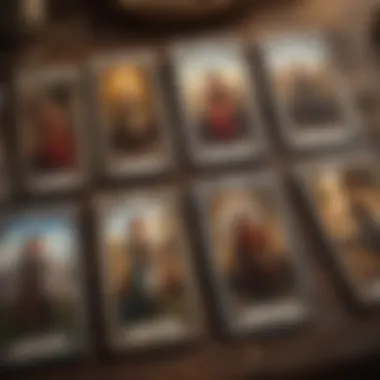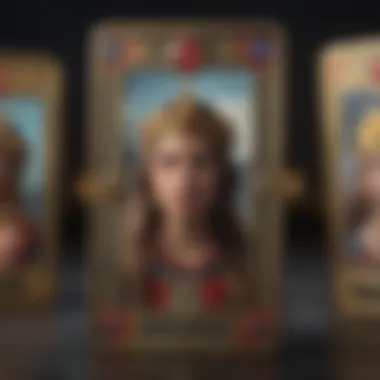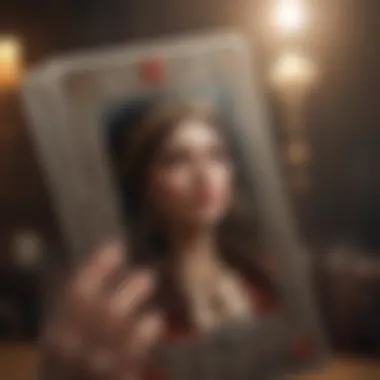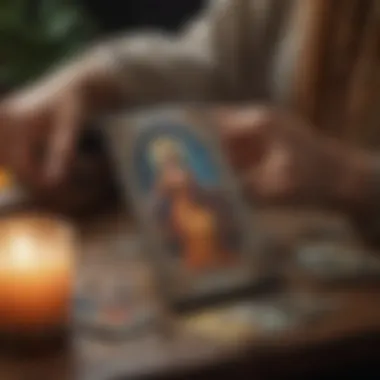Understanding Tarot Decks: Meanings and Interpretations


Intro
Tarot decks encompass a rich tapestry of symbolism and interpretation. Each card serves as a window into both the subconscious and the broader human experience. Understanding the structure and meanings of tarot cards can provide valuable insights, whether for personal reflection or divination.
In this article, we will dissect the components of tarot decks. We will examine not only the meanings of individual cards but also how they function within a reading. This exploration is aimed at both beginners seeking clarity and seasoned practitioners looking to deepen their practice.
Animal Symbolism in Tarot
Tarot decks often feature animals as part of their imagery. Each animal embodies specific traits that can add depth to the interpretation of the card. Common examples include the lion, representing courage, and the owl, symbolizing wisdom. Understanding these associations can enhance the reading experience.
The Structure of a Tarot Deck
Typically, a tarot deck consists of 78 cards. This is split into two main segments: the Major Arcana and the Minor Arcana.
Major Arcana
The Major Arcana includes 22 cards representing significant life events or spiritual lessons. These cards often signify profound insights or turning points in a person's life. Each card is numbered from 0 to 21, starting with The Fool and concluding with The World.
Minor Arcana
Conversely, the Minor Arcana consists of 56 cards divided into four suits: Wands, Cups, Swords, and Pentacles. Each suit corresponds to different aspects of daily life.
- Wands: Associated with creativity and action.
- Cups: Connected to emotions and relationships.
- Swords: Represents intellect and conflict.
- Pentacles: Linked to material aspects and finance.
Understanding these divisions aids in grasping the range of meanings within a tarot reading.
Card Interpretations
The Meanings of Individual Cards
Each card possesses a unique significance that can shift depending on its position in the reading and its relation to other cards. For example, The Lovers card can symbolize romantic partnerships or significant choices, while Death may represent transformation rather than physical death.
Prelude to Tarot Decks
Tarot decks are more than just a tool for fortune-telling; they represent a rich tapestry of history, art, and psychological insight. Understanding tarot decks enhances one’s ability to interpret and connect with the cards. This section will explore crucial elements such as the meaning of tarot decks, their historical significance, and the various components they contain. Each facet informs the reader about how tarot can be a window into both the subconscious and the external world.
What is a Tarot Deck?
A tarot deck consists of 78 cards divided into two main categories: Major Arcana and Minor Arcana. Each card tells a story, laden with symbolism and meaning. The essence of a tarot deck lies not just in the individual cards but in how they interact during a reading. These cards facilitate a dialogue between the querent and their inner self. Engaging with a tarot deck opens pathways for introspection and guidance, making it an essential tool for many.
Historical Background of Tarot
Most historians agree that tarot has its origins in the 15th century in Europe. Initially, the cards were used for playing games, not divination. The transition from gaming cards to spiritual tools materialized in the 18th century when occultists began exploring their esoteric meanings. Tarot became a bridge between the mundane and the mystical, gaining prominence in various spiritual communities. Its historical evolution tells us a lot about societal perceptions of fate, choice, and the unknown.
Components of a Tarot Deck
Understanding the basic structure of a tarot deck is crucial for interpretation. The 78 cards are categorized into two main groups:
- Major Arcana: Composed of 22 cards, these represent significant life events and spiritual lessons.
- Minor Arcana: Composed of 56 cards, divided into four suits—Cups, Wands, Swords, and Pentacles—representing everyday experiences and challenges.
Each card features unique imagery and symbolism, which can be interpreted in various contexts. The imagery often reflects cultural, spiritual, and psychological themes, making it a versatile tool for insight and reflection.
Structure of Tarot Cards
Understanding the structure of tarot cards is crucial for anyone looking to unlock their meanings. Each card serves a distinct purpose and contributes to the comprehensive story told by the deck. The structure not only helps in divination but also enriches personal development practices. By examining how the cards are organized, readers can better understand their implications in various contexts, enhancing the overall insight gained during readings.


Major Arcana Cards
Major Arcana cards represent significant life lessons and themes. Each card stands as a milestone on the journey of life, with meanings that resonate deeply on both individual and universal levels.
The Fool
The Fool is the first card in the Major Arcana. It embodies new beginnings and pure potential. Traditionally depicted as a carefree figure, The Fool invites the seeker to embrace adventure and the unknown. Its key characteristic is spontaneity, making it a popular choice for individuals starting on a new path. The unique feature of this card is its zero number, representing limitless possibilities. However, some may see it as reckless, carrying the disadvantage of caution being overlooked.
The Magician
The Magician symbolizes manifestation and resourcefulness. This card showcases the power of turning ideas into reality. Its key characteristic is mastery, which makes it a beneficial inclusion for those looking to take control of their circumstances. The unique feature of The Magician is the presence of all four suits of the Minor Arcana, indicating a balance of elements. Yet, it may come with the risk of overconfidence, potentially leading to misdirection in its application.
The High Priestess
The High Priestess represents intuition and the inner voice. It encourages seeking wisdom from within. Its key characteristic is mystery, making it a favored card among those who value introspection. This card's unique feature lies in its connection to the subconscious and spiritual realms. However, one disadvantage could be the ambiguity it presents, requiring further exploration to unlock deeper meanings.
The Empress
The Empress embodies fertility, nurturing, and abundance. It reflects comfort and security in both emotional and physical realms. The card's key characteristic of creativity makes it a vital asset for individuals focusing on personal growth. Unique to The Empress is her representation of the Earth element, signifying stability. The downside, however, is a potential overindulgence in comfort, possibly leading to stagnation.
The Emperor
The Emperor stands for authority, structure, and control. He symbolizes the establishment and order. His key characteristic is leadership, making him a beneficial card for those seeking guidance in managing their affairs. The unique feature of The Emperor is his strategic nature, which can provide clarity in chaotic situations. On the other hand, rigidity may also be a risk, limiting flexibility in thought and action.
Minor Arcana Cards
Minor Arcana cards illuminate day-to-day events and experiences. They focus on the practical aspects of life, offering insight into daily interactions and emotional states.
Cups
Cups represent emotions, relationships, and connections. Their key characteristic is intuition, making them essential for understanding emotional depth. Cups are beneficial in highlighting feelings and interpersonal dynamics. A unique feature lies in their fluidity, indicating change and adaptability. However, it could lead to confusion, as emotions might cloud judgment at times.
Wands
Wands symbolize creativity, action, and ambition. Their dynamic energy contributes greatly to personal goals and aspirations. The key characteristic of Wands is enthusiasm, which makes them a popular choice for initiating new projects. Their unique feature is the representation of passion, pushing forward despite obstacles. One disadvantage includes impulsivity, which may lead to burnout if not managed.
Swords
Swords signify intellect, challenges, and conflict. They are crucial for analytical thinking and decision-making. Their key characteristic is clarity, making them effective in addressing complex situations. The unique aspect of Swords is their sharp edges, which can cut through illusion. However, this card may sometimes suggest overthinking, causing paralysis when action is required.
Pentacles
Pentacles represent material aspects, security, and practicality. Their influence is prevalent in discussions of finances and resources. The key characteristic of Pentacles is stability, making them valuable for long-term planning. A unique feature of Pentacles is their association with the Earth element, grounding intentions in reality. Yet, a potential downside is a tendency towards materialism, overshadowing more significant spiritual values.
Interpreting the Major Arcana
Interpreting the Major Arcana is a crucial aspect of understanding tarot decks. The Major Arcana consists of 22 cards that hold deeper meanings and signify important life lessons. Each card is not just a random symbol; it represents a phase or situation in the human experience. Therefore, recognizing the significance of these cards enhances the value of a tarot reading.
The benefits of interpreting the Major Arcana can be profound. It allows seekers to connect with their current life circumstances on a deeper level. When interpreting these cards, practitioners can provide more insightful guidance, helping others on their personal journeys. Understanding this part of the deck lays the foundation for more effective readings.
The Fool's Journey
The concept of The Fool's Journey is essential when discussing the Major Arcana. The Fool, numbered as zero, represents new beginnings and potential. As the protagonist, The Fool embarks on a journey through the remaining 21 cards, each depicting different adventures, trials, and triumphs.
This narrative illustrates personal development and the unfoldment of consciousness. Each card The Fool encounters reflects lessons learned, challenges faced, and wisdom gained. This journey is not linear but rather cyclical, signifying that growth is ongoing. The process allows readers to realize their own path as they interpret the cards reflecting experiences.


Key stages in The Fool's Journey include:
- Innocence: Represented by The Fool itself, suggesting openness to life.
- Growth and Struggles: Depicted in cards like The Empress and The Tower, showcasing both constructive and destructive elements.
- Personal Completion: Reflected in The World, indicating fulfillment and achievement.
The Fool's Journey emphasizes that tarot reading is not merely about divination but also personal storytelling. It encourages a connection between the reader and the seeker, creating an environment for exploration and reflection.
Symbolism of Major Arcana
Each card in the Major Arcana has distinct symbols integrated within its imagery. Understanding these symbols is vital for meaningful interpretations. The symbolism within these cards delves into universal themes, emotions, and archetypes that resonate with human life.
For instance, The Emperor symbolizes authority and structure. Conversely, The High Priestess represents intuition and hidden knowledge. This duality in representation invites reflections on one's inner self and the external world.
Understanding the Minor Arcana
The Minor Arcana represents a foundational aspect of tarot reading, crucial for a comprehensive grasp of tarot decks. Unlike the Major Arcana, which depicts significant life themes and transformations, the Minor Arcana focuses on the day-to-day experiences and events. This distinction helps users understand the nuance between overarching life influences and everyday situations.
The symbols and meanings in the Minor Arcana provide rich opportunities for reflection. Their interpretations can guide personal decisions, highlight present conditions, and reveal the energies surrounding various situations. Each card carries its unique story, woven into the fabric of human experience and interaction.
Suit Meanings and Interpretations
The Minor Arcana is divided into four suits: Cups, Wands, Swords, and Pentacles. Each suit represents different aspects of life, helping users contextualize their readings.
- Cups symbolize emotions and relationships, addressing issues of love, happiness, and connections. When these cards appear, they often evoke feelings or interpersonal dynamics that influence whether the querent should focus on emotional healing or exploring new relationships.
- Wands correspond to action, ambition, and personal growth. These cards shed light on one's drive and aspirations, often reflecting the querent's quest for enlightenment and achievement.
- Swords deal with intellect, conflict, and challenges. They often highlight dilemmas or uncertainties, encouraging practical problem-solving and critical thinking.
- Pentacles relate to material aspects such as work, health, and finances. Pentacle cards provide insights into stability, security, or challenges related to resources.
Each suit yields its interpretations depending on the specific cards drawn and their positions in a spread, enabling users to gain a more profound understanding of the influence those suits have on daily life.
Role of Numbers in Minor Arcana
In the Minor Arcana, numbers play a pivotal role in deepening interpretation. Each number corresponds to specific themes or qualities:
- Ace indicates new beginnings or potential.
- Two suggests choices and duality.
- Three signifies growth and collaboration.
- Four addresses stability and foundations.
- Five introduces conflict or obstacles.
- Six brings about harmony and victory.
- Seven encourages introspection and assessment.
- Eight denotes movement and action.
- Nine symbolizes fulfillment and attainment.
- Ten represents completion or endings.
Understanding the interplay of suits and numbers allows readers to formulate nuanced meanings behind each card. By grasping these numerical principles, one can offer detailed insights into past actions, present situations, and future potentials, enhancing the overall efficacy of a tarot reading.
The Minor Arcana encapsulates the rich variety of daily experiences, offering an accessible look into life's journey that every reader can relate to.
This exploration of the Minor Arcana reflects the intricate nature of tarot, inviting enthusiasts to delve deeper into the connections their cards reveal.
Techniques for Reading Tarot
Reading tarot is not just about the cards themselves; it is also about how a reader interacts with them. Techniques for reading tarot establish a framework through which readers can derive meaning and insight. Understanding these techniques helps in unlocking deeper messages that the cards may hold. Therefore, acquiring a solid grasp of these methods can significantly enhance the overall tarot reading experience.
Shuffling and Spreading the Cards
The act of shuffling and spreading the cards is foundational in tarot reading. It affects the energy of the deck and the outcome of the reading. Shuffling can be meditative. The reader can focus their intention as they mix the cards. Different readers may prefer different methods of shuffling, such as the overhand shuffle, riffle shuffle, or even a more gentle mix.
Once shuffled, the way cards are spread also bears importance. Common spreads like the Celtic Cross or three-card spread provide structure to the reading. Each card's position in the spread correlates with a specific meaning. For instance, the first card may represent the querent's past influences, while subsequent cards can uncover present circumstances or future possibilities.
Practical Applications of Tarot
Tarot decks offer more than just mystique; they serve practical functions in various aspects of life. Understanding the practical applications of tarot enriches the reading experience and enhances personal growth. Tarot readings can guide self-reflection, inform decision-making, and even foster emotional healing. Recognizing these benefits allows practitioners to utilize tarot as a meaningful tool in their endeavors.
Tarot as a Self-Reflection Tool
Tarot cards can facilitate self-exploration. It encourages individuals to dive into their subconscious thoughts and feelings. Using tarot in this manner often leads to insights that might not be immediately apparent. Each card invites inquiry into one's life situations, thus prompting deep introspection.


When engaging in self-reflection through tarot, consider the following elements:
- Personal Understanding: Tarot can mirror personal circumstances, offering perspectives that may go unnoticed in daily life.
- Emotional Awareness: The imagery and symbolism of the cards evoke emotions, encouraging users to confront feelings and unresolved issues.
- Goal Setting: By examining current obstacles through the lens of tarot, an individual can clarify aspirations and create actionable plans.
Utilizing tarot for self-reflection does not require extensive knowledge of the cards. Simple spreads can yield profound revelations. It can be as straightforward as pulling one card each morning to ponder its message throughout the day.
Using Tarot for Decision Making
Making decisions often involves weighing options and considering outcomes. Tarot can serve as a guiding framework for those navigating complex choices. It does not provide definitive answers but rather illuminates various facets of a situation, enabling thoughtful contemplation.
When applying tarot to decision-making, the process may unfold as follows:
- Identifying the Question: Clearly articulate the decision at hand. This may involve writing it down to focus the reading.
- Drawing Cards: Select cards that resonate with the question. Consider various spreads, such as three-card spreads that represent past, present, and future influences.
- Interpreting the Outcome: Analyze how each card relates to the decision. Pay attention to both the immediate context and long-term implications.
By integrating tarot into decision-making, individuals often report greater clarity and confidence. This method sharpens analytical skills and fosters an awareness of intuition, which can significantly impact the quality of one's decisions.
“Tarot does not dictate fate; it offers insights that can empower one's choices.”
Misconceptions About Tarot
Misconceptions about tarot often shape people's understanding and usage of this nuanced tool. Addressing these common fallacies is essential in this article. Clarifying these misconceptions not only provides an accurate view of tarot but also encourages a more profound engagement with its meanings. Furthermore, demystifying these beliefs can empower individuals to utilize tarot in a more meaningful and personal way.
Separating Myth from Reality
Many myths surround tarot, creating barriers for those interested in exploring its depths. One prevailing myth is that tarot is solely a fortune-telling device. In reality, tarot serves a variety of purposes, from self-discovery to guidance. It supports decision-making and can enhance intuition.
Another misconception is that tarot cards possess an inherent magical power. Rather, the interpretations come from the individual’s understanding, experiences, and emotional context. The cards act as catalysts for reflection and pondering on one’s life.
Lastly, some believe that reading tarot requires special abilities or psychic powers. This is untrue; anyone can learn to read tarot by understanding card meanings, symbolism, and their connections. Thus, tarot reading can be viewed as a practice of personal insight rather than a mystical endeavor.
Common Stereotypes
Stereotypes about tarot can greatly affect how people perceive it. One such stereotype is that tarot is only for “new age” individuals or those who claim to be psychics. This limits tarot's accessibility and ignores its rich cultural and psychological contexts.
Another stereotype presents tarot as a tool of deception or manipulation. This notion is vastly exaggerated. While misuse can occur, the vast majority of tarot practitioners strive for honesty and insightfulness in their readings. The focus should be on empowerment rather than control.
Additionally, many assume that all tarot decks carry the same meanings. In fact, each deck will convey its own interpretations, often reflecting the artist’s personal vision. Therefore, a diverse array of decks exists, offering unique insights aligned with various themes or philosophies.
Understanding these misconseptions enriches the experience of tarot, making it a much more valuable tool in personal growth and insight.
By discussing these misconceptions and stereotypes, the article endeavors to foster a more authentic approach to tarot that resonates with both beginners and seasoned practitioners.
Epilogue
In the exploration of tarot decks and their multifaceted meanings, we have embarked on a journey through symbolic representations and the art of divination. This conclusion serves to distill the essence of the insights gained throughout the article. Understanding tarot is not merely about card meanings; it involves recognizing the layers of interpretation and the cultural significance they carry.
Summarizing the Essence of Tarot
Tarot is a complex interplay of imagery, intuition, and context. Each card tells its own story, but they also work together in a reading to form a cohesive narrative. The Major Arcana reflects significant life events and spiritual lessons, while the Minor Arcana deals with day-to-day experiences. This duality enriches the tarot experience, allowing users to find personal meaning in the readings.
Moreover, tarot serves as a reflection tool, enabling individuals to confront their fears, desires, and potential paths. This dual role—both as a tool for divination and personal growth—makes tarot a unique practice that can be enriched through study and personal experience. It encourages reflection and self-awareness, often leading to transformative insights. Many find a sense of empowerment in their ability to interpret cards, even if straight away they fumble a bit with meanings. This personal connection fosters a greater understanding, making the study of tarot both an art and a science.
Looking Ahead: The Future of Tarot Reading
The future of tarot reading holds promise and evolution. As society becomes more aware of mental health and self-exploration, the use of tarot may become more mainstream, as a valuable resource for reflection and decision-making. New decks emerge often, each with distinct artistic styles and interpretations, enriching the landscape of tarot. The incorporation of technology, such as tarot apps and digital readings, signifies a shift in how individuals engage with this ancient practice.
Additionally, interaction within online communities, such as those on platforms like Reddit and Facebook, fosters sharing of insights and interpretations from diverse perspectives. Bookmarking resources like Wikipedia and Britannica can provide further understanding and context surrounding this evolving field.
As individuals continue to seek tools that promote mindfulness and insight, tarot is likely to retain its place in personal development and spiritual practices. Engaging thoughtfully with tarot will allow for deeper personal connections and enriched understanding of oneself and the world.
"Tarot is a mirror, reflecting the inner workings of the mind and the nuances of the human experience."







